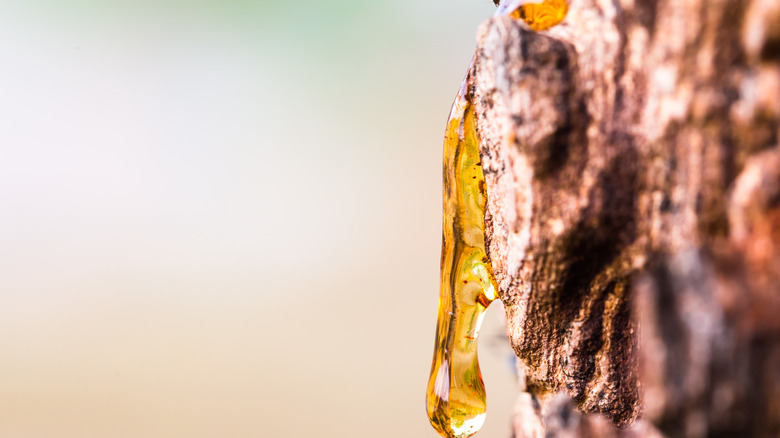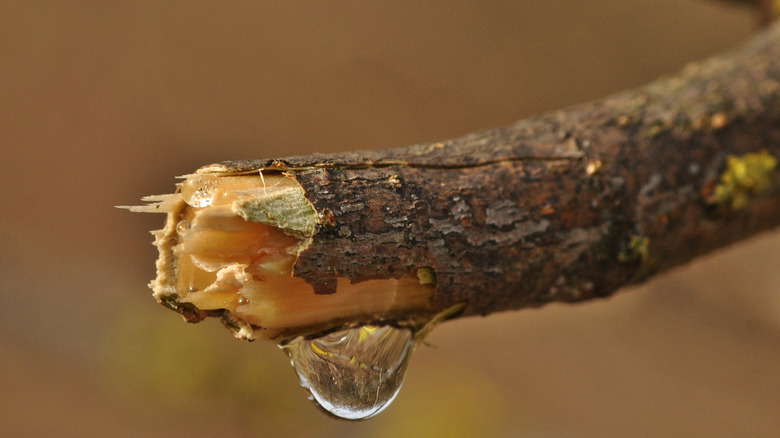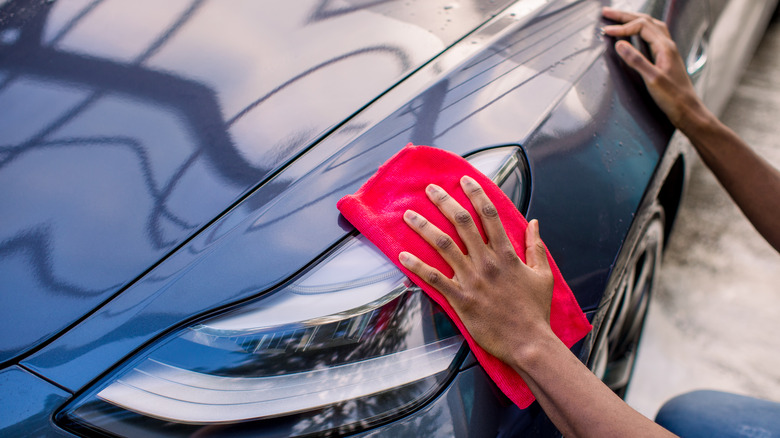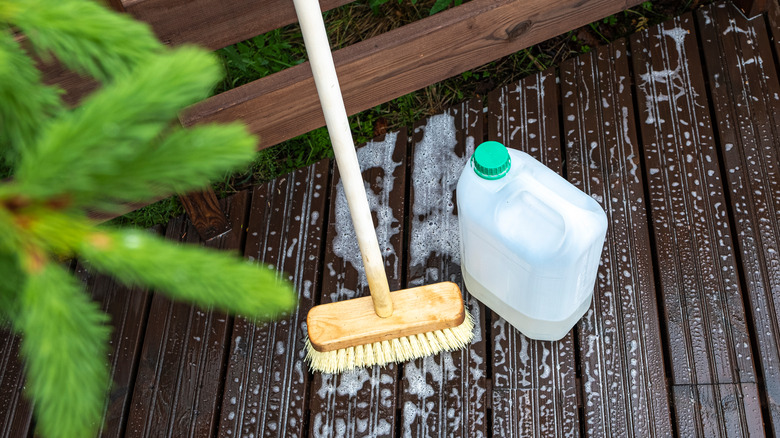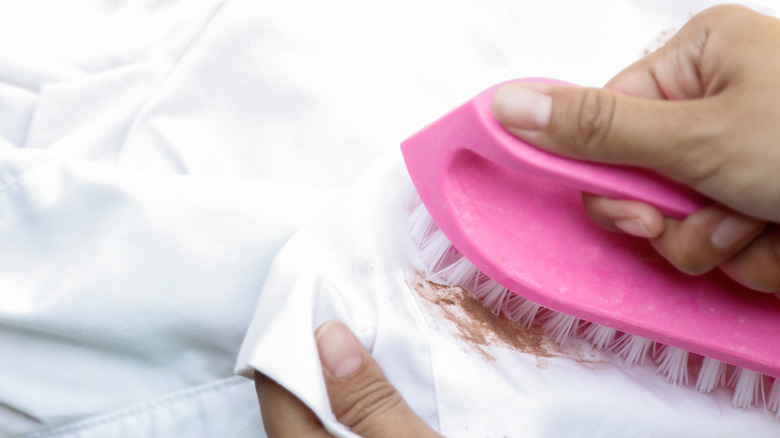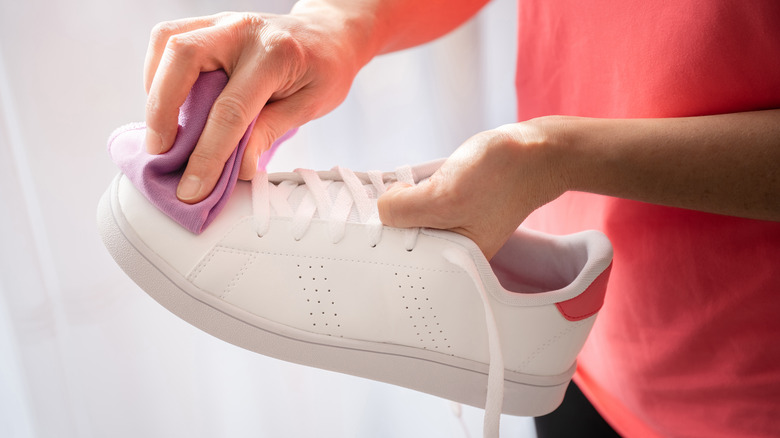The Best Ways To Clean Up Tree Sap
We may receive a commission on purchases made from links.
Tree sap, AKA "that goo-like sticky stuff dripping on my car, rooftop, shirts," just like human blood, is the liquid engine circulating sugar, water, and photosynthesized food within deciduous trees — that is, until it's exposed to the external world where it becomes a headache that sticks. Often, pine, oak, maple, willow, and some fruit-bearing trees will leak sap as a sign of healthy budding. However, in some other cases, sap bleeding is a response to seasonal changes, a tree wound caused by pruning, or a defense mechanism against a potential invasion of pests/diseases (via Garden Guides).
In pines and other "heavy bleeders," Big Trees writes that seasonal sap outflow begins in spring (in the largest volume), slows down in summer, and stops in winter; the cycle repeats the following spring. But unless you're one of those folks who convert sap to delicious home-made syrup or candies (enough to keep the bleeding in check), your rooftop, gutter, car, flower plants, and even the residents of your home are sure to suffer awful damages caused by tree sap, says Giroud Tree And Lawn (via Cision PRWeb). And if the crazy moments are already unfolding (for example, dripping sap tacking your hair into an inseparable clump so much you had to trim and regrow), this article will be an eye-opener into the eight best ways to clean up tree sap off anything.
Remove sap from hair using oil, hairdryer, and comb
Picture this: It's spring on a cool weekend evening, and you and some friends are engrossed in a discussion in the shade of a sap-producing tree. Before you know it, you all have your hair covered in drips of sap. Big mess? Yes. It's like having chewed bubblegum stuck in your hair.
Detangling with combs directly will spread the thing further or even pluck out hair painfully. In a situation like this, Gardening Know How explains that you have to first dissolve the sticky sap for painless, instant comb-lifting. That's where oil-based products and hairdryer play a role. For thicker sap in larger globs, Hair Finder recommends covering the lump in either baby oil, peanut oil, or pine oil, all of which have the most gum-dissolving capacities. Otherwise, a decent amount of mayonnaise or vegetable oil is enough when the situation is not too serious.
Either way, after application, leave the oil to sit and soak into the hair for 15 to 20 minutes, at the end of which you soften the sticky nuisance further using a hairdryer on a warm settings (not hot enough to cause scalp damage, please). Finally, gently comb out softened clumps with a wide-toothed comb before washing, rinsing, and drying out the hair.
Clean sap from skin using alcohol or dish soap
Tree sap is beneficial to the skin; it's a natural anti-inflammatory agent that also packs astringent and antiseptic properties for wound treatment (via Cement Answers). But the stains it can leave on your skin, especially when least expected, are like being force-fed cough syrup when you don't need it. It may not cause any health issues, but it can be annoying.
So, whether you've just moved a live Christmas tree into or out of your home, pruned some evergreens, or cleared your property and wound up with sticky trails on your body, there are no health concerns to be worried about — all you have to do is clean it off. To get tree sap off of your hands, says Budget101, simply rub with olive oil and wash with dish soap and water, though peanut butter can take the place of olive oil. Now, if the sap is on a region of your body that's out of reach, you may need someone to wipe it off using a washcloth or cotton ball soaked in either alcohol or methylated spirit.
Remove sap from car with gel hand sanitizer
Out of an abundance of caution, in summer, you more often park your car under trees where it's shaded from heat and dust. Good idea, but you then risk exposing your car to large swaths of sticky "tree blood." When this happens and is left unresolved, Auto Detailing Pro shares that the acid and sugar content of sap can react with car paint, causing discoloration or blemishes. Even if you notice the gummy stains before they dry, washing with regular soap solution is not ideal.
Town & Country offers the best solution: gel hand sanitizer. The first step is to pressure-wash the entire car with warm water to loosen up the sap. Step two, squeeze a fingertip-size dab of gel hand sanitizer each directly to the sap stain and let it sit there. A few seconds after that, the stain will dissolve and be ready to be wiped off with damp rags or wet tissue paper. Alternatively, Love To Know suggests using rubbing alcohol this same way, but with caution as alcohol reacts with some paints.
However, all of that is for car exteriors alone; if you by chance wind up with sap stains on floor mats, seats, fabric upholstery, or any other interior part of a vehicle, the best solution is to spray with instant sticky gel remover for vehicles. We recommend Turtle Wax T-520A Bug And Tar Remover or Mothers 08224 California Gold Instant Detailer.
Restore wooden decks or patios with deck stripper and brush
Gummy tree discharge can land on your wooden deck and become an unruly sight, especially in rainy seasons where it easily clings to rain boots when accidentally stepped into. That's why we recommend the real deal: a deck stripper which completely strips your deck or patio of age-old sticky sap and brings about real restoration.
Deck stripper is a biodegradable liquid for eliminating sticky materials, dirt, mildew, algae, and mold from wooden surfaces. To use it for sap removal from any wooden surface, How To Clean Stuff advises that you purchase Saver System Deck Wood Stain Stripper from a home improvement store, apply the liquid gently to the affected areas using a stiff bristle brush, and allow up to 15 minutes (or slightly over) for the stripper to dissolve the sap. Now, with the same brush, scrub sap off in the direction of the wood grain, then finally hose down the deck with clean water to send sap away for good.
Alternatively, Bob Vila suggests mopping oil soap over the affected areas, via the same process explained for deck stripper. Remember, always apply either of these products in the direction of wood grain; scrubbing across or against the grain will leave visible, ugly marks on your patio, which will in turn require the additional work of sanding to eliminate them.
Eliminate tree sap from clothing with stain remover and brush
FYI, you don't have to be a tree-hugger to wind up with sap-stained shirts and pants. For example, your clothing can get stained by "gum pitches" while saving your cat from a tree, or receive a few drops here and there when resting under a tree after a long forest hike. In most cases, the marks are from a sap-dripping tree or an indirect source (for example, reclining against sap deposits on your vehicle door).
Going by the six-step guide written by The Spruce, you can convert any clothing from sap-ruined to occasion-ready. Here's how. Step one: Pretreat the sticky stains by applying enzyme-based stain remover or heavy-duty liquid laundry detergent. For white shirts, we recommend Oxiclean Revive Laundry Whitener + Stain Remover or Oxiclean Versatile Stain Remover for colored clothing. Next, work stain remover gently over sap stains and let it sit for 15 to 20 minutes. Now, rinse out the dissolved, smeared sap with warm water repeatedly. If you notice any remaining sticky pitch after several passes, repeat the process. Finally, for the machine wash-friendly clothing, wash at hot temperature and allow to dry.
Take note: Sap dries and gets hardened quickly. If your outfit gets stained and you can't use enzyme-based stain remover on it, use a brush, warm water, and a washing machine. Squeeze a few drops of alcohol to spirit away the smears as much as possible.
Get rid of sap from shoes by freezing and scraping
Sticky tree sap, be gone! Nice try, but it doesn't work that way. One of the aftermaths of camping (yes, even backyard camping around evergreens), hunting, hiking, and moving a Christmas tree is ending up with patches of gluey tree fluid on your shoes or boots. The bad news is, unlike your stained deck, shirts, or car, most dishwashing soaps can be too harsh for leather shoes (via Tips Bulletin). And the gentler soaps may not be tough enough to lift off the tacky fluid.
So, what gives? Well, Backpacker explains the freeze-and-scrape technique that works like charm, and here are the steps. First off, zip the affected shoes in plastic bags and allow them to freeze in a refrigerator or freezer. Alternatively, collect ice cubes in a plastic bag and bring them in contact with the adhesive tree stains to freeze them up. Next up, scrape off frozen blobs with a plastic scraper or butter knife. Finally, dap and wipe the leather surface with either a cotton ball or a paper towel soaked in rubbing alcohol. Yes, that's all, but of course you still need to wash those shoes the regular way to eliminate other stains. Anyway, it is noteworthy that Bob Vila also recommends this same method for cleaning sap from clothes.
Unglue sap from pet fur with scissors or olive oil
Don't leash or chain your doggo, they say. Golden retrievers are super intelligent and can stay clean all day, they say. But how does your four-legged friend keep winding up with gummy thingies in its fur? Thing is, rolling around in leaf piles and playing around trees are some pet-favorite activities. And while we at House Digest also say no to dog chaining and completely shun every other form of animal cruelty, we also understand how uncomfortable your dog or cat would be with sap-clumped fur. So, whenever the unwanted happens, Daily Puppy instructs you to get a pair of blunt-tip scissors, a dog comb, and olive oil and follow the process below.
First thing, gently hand-pick out the bits you can right away. Don't do this aggressively, otherwise your pet will shed painfully. Now, trim off the more sticky patches at the surface without moving scissors too close to the skin. FYI, trimming may not be ideal when the patches are everywhere. In this case, apply olive oil for five to 10 minutes to saturate the problem for easy comb-lifting. Finally, bathe your fur baby with fur shampoo to wash off the olive oil.
Take note, some people use nail polish remover, WD-40, rubbing alcohol, or Goo Gone in place of olive oil. But it has come to our notice, thanks to Top Dog Health, that these are toxic home remedies one should avoid using on their pets.
